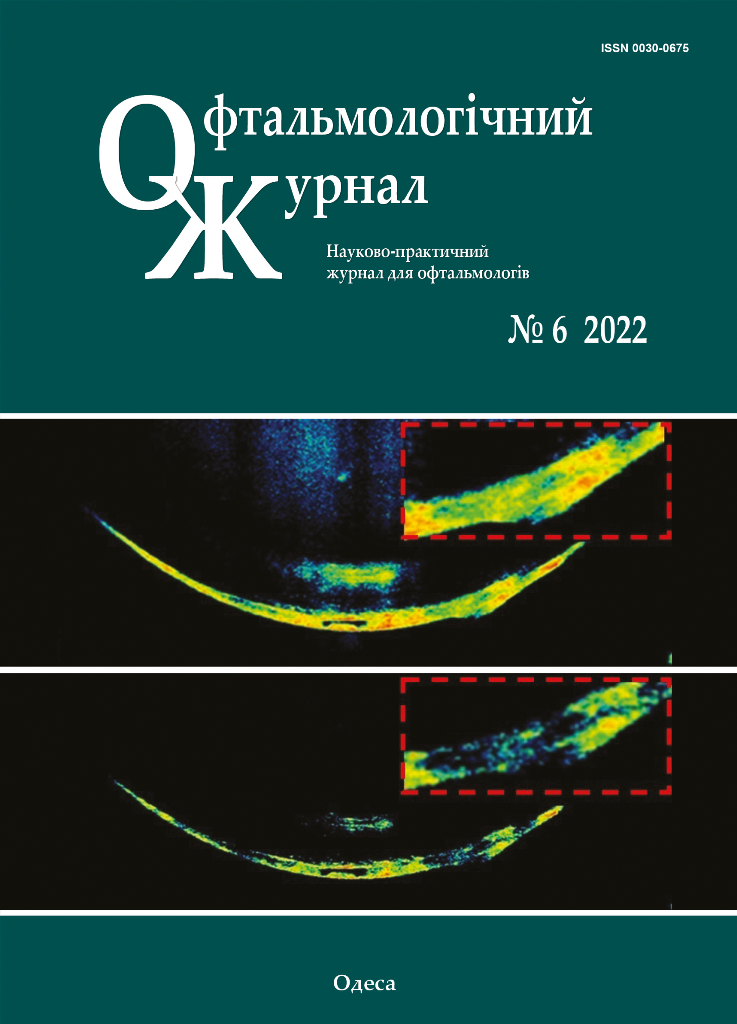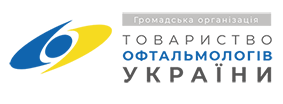Наш досвід лазерної іридотомії у пацієнтів із хронічною закритокутовою глаукомою
DOI:
https://doi.org/10.31288/oftalmolzh202261013Ключові слова:
хронічна закритокутова глаукома, лазерна іридотомія, гоніоскопія, факоемульсифікація катаракти, гоніосинехіолізис, оптична когерентна томографія кута передньої камериАнотація
Вступ. Визначення тактики хірургічного лікування хронічної закритокутової глаукоми (ХЗКГ) залишається актуальним питанням офтальмології.
Мета. Дослідити гіпотензивний ефект, його тривалість та ступінь розширення кута передньої камери після лазерної іридотомії (ЛІ) у пацієнтів із ХЗКГ.
Матеріал та методи. Було обстежено 31 пацієнтів (31 око) із ХЗКГ, котрим була проведена ЛІ. Серед них було 18 жінок та 13 чоловіків. Середній вік пацієнтів становив 64,8 ± 5,3 років (від 49 до 77 років). Звуження КПК від 30° до 20° (Shaffer 2 ‒ Shaffer 3) та наявність глаукомної оптичної нейропатії були показами для проведення ЛІ. Внутрішньоочний тиск (ВОТ) становив, в середньому, 23,4±1,2 мм рт. ст. за Маклаковим.
Результати. До закінчення терміну спостереження у зв'язку із підвищенням ВОТ та звуженням КПК при гоніоскопії (менше 20° ‒ Shaffer 2) хірургічного втручання потребували 13 пацієнтів (10 очей – ФЕК та 3 – ФЕК+гоніосинехіолізис (ГСЛ). Таким чином тривалість гіпотензивного ефекту ЛІ за критерієм потреби хірургічного лікування (ФЕК або ФЕК+ГСЛ) з використанням методу Каплaн-Меєра становила 87,1% до кінця першого року, 71% ‒ до кінця другого року і 58,06% ‒ до кінця третього року спостереження.
Висновки. У довгостроковій перспективі (понад 6 місяців) лазерна іридотомія менш ефективно знижує ВОТ і не забезпечує відкриття кута передньої камери. Лазерну іридотомію можна розглядати як підготовчу процедуру у разі ХЗКГ, зокрема у випадках гострого нападу глаукоми на парному оці.
Посилання
1.Quigley HA, Broman AT. The number of people with glaucoma worldwide in 2010 and 2020. Br J Ophthalmol. 2006 Mar;90(3):262-7. https://doi.org/10.1136/bjo.2005.081224
2.Tham Y-C, Li X, Wong TY, Quigley HA, Aung T, Cheng C-Y. Global prevalence of glaucoma and projections of glaucoma burden through 2040: a systematic review and meta-analysis.
3.Ophthalmology. 2014 Nov;121(11):2081-90. https://doi.org/10.1016/j.ophtha.2014.05.013
4.Peng PH, Nguyen H, Lin HS, et al. Long-term outcomes of laser iridotomy in Vietnamese patients with primary angle closure. Br J Ophthalmol. 2011;95(9):1207-1211. https://doi.org/10.1136/bjo.2010.181016
5.Rao A, Rao HL, Kumar AU, Babu JG, Madhulata U, Arthi J, et al. Outcomes of Laser Peripheral Iridotomy in Angle Closure Disease. Semin Ophthalmol. 2013;28:4e8. https://doi.org/10.3109/08820538.2012.702260
6.Chen MJ, Cheng CY, Chou CK, et al. The long-term effect of Nd:YAG laser iridotomy on intraocular pressure in Taiwanese eyes with primary angle-closure glaucoma. J Chin Med Assoc 2008;71:300-4. https://doi.org/10.1016/S1726-4901(08)70126-6
7.Аlsagoff Z, Aung T, Ang LP, Chew PT. Long-term clinical course of primary angle-closure glaucoma in an Asian population. Ophthalmology. 2000;107:2300-4. https://doi.org/10.1016/S0161-6420(00)00385-7
8.Chew PT, Aung T. Primary angle-closure glaucoma in Asia. J Glaucoma. 2001;10(suppl):S7- 8. https://doi.org/10.1097/00061198-200110001-00004
##submission.downloads##
Опубліковано
Як цитувати
Номер
Розділ
Ліцензія
Авторське право (c) 2025 Р. М. Лопадчак, І. Я. Новицький, Я. З. Федус

Ця робота ліцензується відповідно до Creative Commons Attribution 4.0 International License.
Ця робота ліцензується відповідно до ліцензії Creative Commons Attribution 4.0 International (CC BY). Ця ліцензія дозволяє повторно використовувати, поширювати, переробляти, адаптувати та будувати на основі матеріалу на будь-якому носії або в будь-якому форматі за умови обов'язкового посилання на авторів робіт і первинну публікацію у цьому журналі. Ліцензія дозволяє комерційне використання.
ПОЛОЖЕННЯ ПРО АВТОРСЬКІ ПРАВА
Автори, які подають матеріали до цього журналу, погоджуються з наступними положеннями:
- Автори отримують право на авторство своєї роботи одразу після її публікації та назавжди зберігають це право за собою без жодних обмежень.
- Дата початку дії авторського права на статтю відповідає даті публікації випуску, до якого вона включена.
ПОЛІТИКА ДЕПОНУВАННЯ
- Редакція журналу заохочує розміщення авторами рукопису статті в мережі Інтернет (наприклад, у сховищах установ або на особистих веб-сайтах), оскільки це сприяє виникненню продуктивної наукової дискусії та позитивно позначається на оперативності і динаміці цитування.
- Автори мають право укладати самостійні додаткові угоди щодо неексклюзивного розповсюдження статті у тому вигляді, в якому вона була опублікована цим журналом за умови збереження посилання на первинну публікацію у цьому журналі.
- Дозволяється самоархівування постпринтів (версій рукописів, схвалених до друку в процесі рецензування) під час їх редакційного опрацювання або опублікованих видавцем PDF-версій.
- Самоархівування препринтів (версій рукописів до рецензування) не дозволяється.












